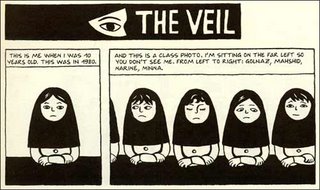PERSEPOLIS on Campus
 A week ago I had the honor of addressing a group of "First Year Experience" instructors at Russell Sage College in Troy, NY, on Marjane Satrapi's graphic novel Persepolis. I was invited by English Department head (and good friend) David A. Salomon to speak about graphic novels and comics in general, as well as some specific strategies for reading comics and Persepolis in specific.
A week ago I had the honor of addressing a group of "First Year Experience" instructors at Russell Sage College in Troy, NY, on Marjane Satrapi's graphic novel Persepolis. I was invited by English Department head (and good friend) David A. Salomon to speak about graphic novels and comics in general, as well as some specific strategies for reading comics and Persepolis in specific.The instructors - a mix of faculty, staff, and post-first-year students - were looking for a bit of guidance on how to talk about a comics text in a classroom setting, especially to groups of brand-new college students. Persepolis was chosen as a text that all incoming students would read, a strategy becoming more and more poular on campuses throughout the country - see, for example, this article from Thursday's Roanoke [VA] Times.
Over a pizza lunch, I presented a quick-n-dirty run-down on comics as a unique form of expression (like drama, or poetry, or prose narrative, or film), followed by a close reading of a few pages from Persepolis. I tried to demonstrate ways in which the arrangement of images and text on the comics page can combine to suggest ideas above and beyond simply "what the words say" and "what the pictures represent."
We had a lively question-and-answer session, where discussion ranged from broad topics like "why comics in the first place?" to parallels with and differences between Persepolis and the other text the new first-year students had read for the course, Firoozeh Dumas' Funny in Farsi. I hope to hear how the semester progresses; it seemed like a very enthusiastic and dedicated group of instructors.
Site Update News: As part of my preparation for the talk, I created a "ComicsResearch.org In-Depth Information Page for Marjane Satrapi". These Info Pages (see also our page on Art Spiegelman's Maus) collect information on interviews, media appearances, on-line reference entries, shorter print resources, publication histories, and more. Watch for announcements about more of these in-depth pages soon.


0 Comments:
Post a Comment
<< Home